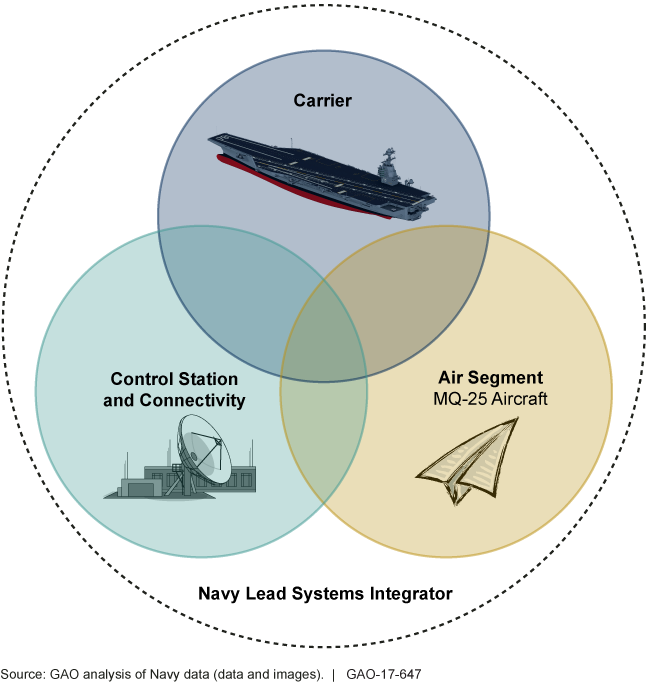Navy Unmanned Aerial Refueling System: Acquisition Addresses Validated Requirements and Reflects a Knowledge-Based Approach
Fast Facts
The Navy is planning to begin its MQ-25 program, which is a drone with two key requirements: it should be able to operate from an aircraft carrier, and refuel other aircraft while in flight.
We found that the Navy's planned approach to acquire the MQ-25 generally looks sound. With the program still quite early in its life cycle, program success will largely depend on the Navy’s ability to (1) make a business case for starting development in 2018, and (2) effectively implement its planned approach.
Integration of Essential Segments of the MQ-25 System

Venn diagram showing that carriers, control stations, and drones must be integrated to operate.
Highlights
What GAO Found
The MQ-25 requirements have been validated by DOD's Joint Requirements Oversight Council. The Navy has identified two primary requirements: carrier suitability, which means the ability to operate on and from the Navy's aircraft carriers; and air refueling, which is the ability to provide fuel to other carrier-based assets while in flight. While the MQ-25 system is also expected to possess intelligence, surveillance and reconnaissance capabilities; those capabilities are not considered primary requirements. According to the program's acquisition strategy, the MQ-25 system will consist of three segments: the Air segment; a control and connectivity segment, which will interface with existing command and control systems; and an aircraft carrier segment, which will make modifications to upgrade existing carrier infrastructure. These three segments will be managed and integrated by the Navy's Unmanned Carrier Aviation program office, acting as a Lead Systems Integrator (see figure below).
Three Key Segments of the MQ-25 System

The Navy has established a knowledge-based approach for acquiring the MQ-25 aircraft. For example, the Navy plans to take an incremental approach to develop and evolve the MQ-25 over time. Further, the Navy expects to use knowledge-based criteria to assess progress at key decision points during development, and to use only technologies with high levels of maturity. With the Milestone B review scheduled in the summer of 2018—signaling the beginning of development—the ultimate success of the MQ-25 program depends heavily on the Navy's ability to present an executable business case and then effectively implement its planned approach.
Why GAO Did This Study
The Navy expects to invest almost $2.5 billion through fiscal year 2022 in the development of an unmanned aerial refueling system referred to as the MQ-25 . The MQ-25 is the result of a restructure of the former Unmanned Carrier-Launched Airborne Surveillance and Strike system. The program is expected to deliver an unmanned aircraft system that operates from aircraft carriers and provides aerial refueling to other Navy aircraft and intelligence, surveillance, and reconnaissance capabilities. The Navy plans to release a request for proposals for air system development by October 2017 and award a development contract one year later.
A House Armed Services Committee report on a bill for the National Defense Authorization Act for Fiscal Year 2017 contained a provision for GAO to review the status of the MQ-25 program. This report assesses the extent to which the MQ-25's acquisition strategy is (1) rooted in validated requirements and (2) structured to follow a knowledge-based acquisition process.
To do this work, GAO reviewed the Navy's requirements documentation, acquisition strategy, and other relevant documents and compared them with acquisition statutes, Department of Defense acquisition policy, and previous GAO reports and best practices. GAO also discussed the MQ-25 requirements and acquisition strategy with the Navy program office and other cognizant officials.
Recommendations
GAO is not making recommendations. DOD's technical comments are incorporated in this report.
